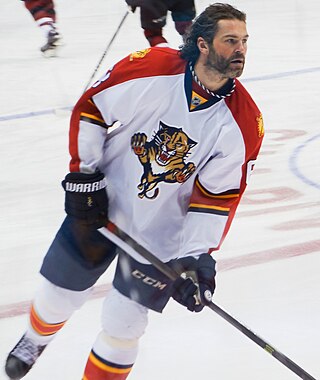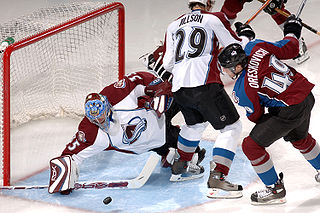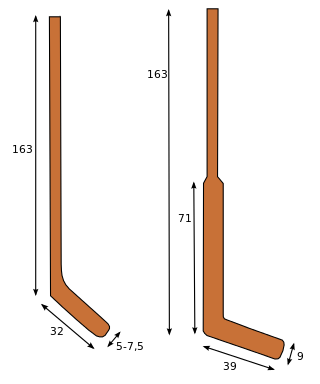
Ice hockey is a team sport played on ice skates, usually on an ice skating rink with lines and markings specific to the sport. It belongs to a family of sports called hockey. In ice hockey, two opposing teams use ice hockey sticks to control, advance, and shoot a closed, vulcanized, rubber disc called a "puck" into the other team's goal. Each goal is worth one point. The team which scores the most goals is declared the winner. In a formal game, each team has six skaters on the ice at a time, barring any penalties, one of whom is the goaltender. Ice hockey is a full contact sport, and is considered to be one of the more physically demanding team sports. It is distinct from field hockey, in which players move a ball around a non-frozen pitch using field hockey sticks.

In many team sports that involve scoring goals, the goalkeeper is a designated player charged with directly preventing the opposing team from scoring by blocking or intercepting opposing shots on goal. Such positions exist in bandy, rink bandy, camogie, association football, Gaelic football, international rules football, floorball, handball, hurling, field hockey, ice hockey, roller hockey, lacrosse, ringette, rinkball, water polo, and shinty, as well as in other sports.

In ice hockey, a goal is scored when the puck entirely crosses the goal line between the two goal posts and below the goal crossbar. A goal awards one point to the team attacking the goal scored upon, regardless of which team the player who actually deflected the puck into the goal belongs to. Typically, a player on the team attempting to score shoots the puck with their stick towards the goal net opening, and a player on the opposing team called a goaltender tries to block the shot to prevent a goal from being scored against their team.

The centre in ice hockey is a forward position of a player whose primary zone of play is the middle of the ice, away from the sideboards. Centres have more flexibility in their positioning and therefore often end up covering more ice surface than any other player. Centres are ideally strong, fast skaters who are able to backcheck quickly from deep in the opposing zone. Generally, centres are expected to be gifted passers more so than goal scorers, although there are exceptions - typically larger centres who position themselves directly in front of the net in order to score off rebounds. They are also expected to have exceptional "ice vision", Hockey IQ, intelligence, and creativity. They also generally are the most defensively-oriented forwards on the ice, as they are expected to play the role of the third player in defense, after the defencemen. Centres usually play as part of a line of players that are substituted frequently to keep fresh and keep the game moving.

Winger, in the game of ice hockey, is a forward position of a player whose primary zone of play is along the outer playing areas. They typically flank the centre forward. Originally the name was given to forward players who went up and down the sides of the rink. Wingers generally have the least defensive responsibilities out of any position on the ice, however they are still tasked with defensive duties such as forechecking duties or covering the point in the defensive zone.

Defence or defense in ice hockey is a player position that is primarily responsible for preventing the opposing team from scoring. They are often referred to as defencemen, D, D-men or blueliners. They were once called cover-point.

In ice hockey, the goaltender is the player responsible for preventing the hockey puck from entering their team's net, thus preventing the opposing team from scoring. The goaltender mostly plays in or near the area in front of the net called the goal crease. Goaltenders tend to stay at or beyond the top of the crease to cut down on the angle of shots. In the modern age of goaltending there are two common styles, butterfly and hybrid. Because of the power of shots, the goaltender wears special equipment to protect the body from direct impact.

A penalty in ice hockey is a punishment for an infringement of the rules. Most penalties are enforced by sending the offending player to a penalty box for a set number of minutes. During the penalty the player may not participate in play. Penalties are called and enforced by the referee, or in some cases, the linesman. The offending team may not replace the player on the ice, leaving them short-handed as opposed to full strength. When the opposing team is said to be on a power play, they will have one more player on the ice than the short-handed team. The short-handed team is said to be "on the penalty kill" until the penalty expires and the penalized player returns to play. While standards vary somewhat between leagues, most leagues recognize several common varieties of penalties, as well as common infractions.

A face-off is the method used to begin and restart play after goals in some sports using sticks, primarily ice hockey, bandy, floorball, broomball, rinkball, and lacrosse.
Checking in ice hockey is any of a number of defensive techniques aimed at disrupting an opponent with possession of the puck or separating him from the puck entirely. Most types are not subject to penalty.
In ice hockey, a penalty shot is a type of penalty awarded when a team loses a clear scoring opportunity on a breakaway because of a foul committed by an opposing player. A player from the non-offending team is given an attempt to score a goal without opposition from any defending players except the goaltender. This is the same type of shot used in a shootout to decide games in some leagues.

A shot in ice hockey is an attempt by a player to score a goal by striking or snapping the puck with their stick in the direction of the net.

A breakaway is a situation in ice hockey in which a player with the puck has no defending players, except for the goaltender, between himself and the opposing goal, leaving him free to skate in and shoot at will. A breakaway is considered a lapse on the part of the defending team. If a player's progress is illegally impeded by an opposing player or if the goalie throws his stick at the oncoming player, the breakaway player is awarded a penalty shot. If a player faces an empty net and is illegally impeded by an opposing player, he is automatically awarded a goal for his team instead of taking a penalty shot.

Floor hockey is a broad term for several indoor floor game codes which involve two teams using a stick and type of ball or disk. Disks are either open or closed but both designs are usually referred to as "pucks". These games are played either on foot or with wheeled skates. Variants typically reflect the style of ice hockey, field hockey, bandy or some other combination of sport. Games are commonly known by various names including cosom hockey, ball hockey, floorball, or simply floor hockey.

Roller in-line hockey, American roller hockey or inline hockey, is a variant of hockey played on a hard, smooth surface, with players using inline skates to move and ice hockey sticks to shoot a hard, plastic puck into their opponent's goal to score points. The sport is a very fast-paced and free-flowing game and is considered a contact sport, but body checking is prohibited. There are five players including the goalkeeper from each team on the rink at a time, while teams normally consist of 16 players. There are professional leagues, one of which is the National Roller Hockey League (NRHL). While it is not a contact sport, there are exceptions, i.e. the NRHL involves fighting.

The National Hockey League rules are the rules governing the play of the National Hockey League (NHL), a professional ice hockey organization. Infractions of the rules, such as offside and icing, lead to a stoppage of play and subsequent face-offs, while more serious infractions lead to penalties being assessed to the offending team. The league also determines the specifications for playing equipment used in its games.

An ice hockey stick is a piece of equipment used in ice hockey to shoot, pass, and carry the puck across the ice. Ice hockey sticks are approximately 150–200 cm long, composed of a long, slender shaft with a flat extension at one end called the blade. National Hockey League (NHL) sticks are up to 63 inches long. The blade is the part of the stick used to contact the puck, and is typically 25 to 40 cm long. Stick dimensions can vary widely, as they are usually built to suit a particular player's size and preference. The blade is positioned at roughly a 135° angle from the axis of the shaft, giving the stick a partly 'L-shaped' appearance. The shaft of the stick is fairly rigid, but is slightly elastic to improve shot performance.
This is a list of common terms used in the sport of ice hockey along with the definitions of these terms.

A penalty shot or penalty kick is a play used in several sports whereby a goal is attempted during untimed play. Depending on the sport, when a player commits certain types of penalties, the opposition is awarded a penalty shot or kick attempt. The rules on how a player attempts a penalty shot or kick also varies between sports.
In ice hockey, an awarded goal is an unusual situation in which a goal is awarded to a team rather than scored. A penalty shot is a type of penalty awarded when a team loses a clear scoring opportunity on a breakaway because of a foul committed by an opposing player. A player from the non-offending team is given an attempt to score a goal without opposition from any defending players except the goaltender. However, when such a lost opportunity occurs and the opposing team has pulled its goalie to allow for an extra attacker, a goal is simply awarded without a penalty shot taking place.















